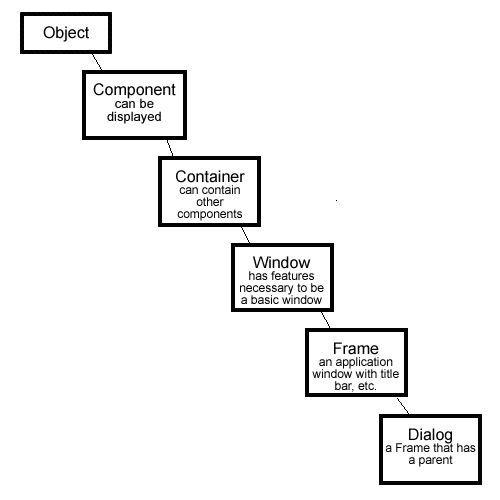public class Person { String name; int age; Person(){ name = "Penda"; age = 20; } Person(String name){ this.name=name; age=20; } Person(int age){ name="Pijo"; this.age=age; } Person(String name, int age){ this.name=name; this.age=age; } public static void main(String[] arg){ Person ps[]=new Person[4]; ps[0]= new Person(); ps[1]= new Person(22); ps[2]= new Person("Kami"); ps[3]= new Person("Simo",26); main(ps); } public static void main(Person[] ps){ for(int i=0;i<ps.length;i++){ System.out.print(ps[i].name); System.out.println(" age: "+ps[i].age); } } } |
Penda age: 20 Pijo age: 22 Kami age: 20 Simo age: 26 |
Inheritance creates a new class definition by building upon an existing definition (you extend the original class)
The new class can, in turn, can serve as the basis for another class definition
The keyword extends is used to base a new class upon an existing class
Several pairs of terms are used to discuss class relationships (these are not keywords)

"is a " relation. A derived class instance may be used in any place a base class instance would work - as a variable, a return value, or parameter to a method
Inheritance is used for a number of reasons (some of the following overlap)
When extending a class, you can add new properties and methods, and you can change the behavior of existing methods (which is called overriding the methods)
class SupClasse{
float fl;
void func() {…}
}
class ExtClasse extends SupClasse{ //2
data members and 2 methods
int in;
void func2(){…};
}
Variables with the same names
class SupClasse{
float fl;
int s;
void func() {…}
}
class ExtClasse extends SupClasse{ //4
data members and 2 methods
int in;
int s;
void func2(){
int s2 = s;
int s1 =
super.s;
…
};
}
Methods with the same names - overriding
When a method is called through a reference, the JVM looks to the actual class of the instance to find the method. If it doesn't find it there, it backs up to the ancestor class (the class this class extended) and looks there (and if it doesn't find it there, it backs up again, potentially all the way to Object).
Sooner or later, it will find the method, since if it wasn't defined somewhere in the chain of inheritance, the compiler would not have allowed the class to compile.
In this manner, what you could consider the most advanced (or most derived) version of the method will run, even if you had a base class reference| start with: java Shapes | |
class Shape { public String toString() { return "Shape"; } } class Circle extends Shape { public String toString() { return "Circle"; } } class Square extends Shape { public String toString() { return "Square"; } } class Triangle extends Shape { public String toString() { return "Triangle"; } } public class Shapes{ |
0:
Shape 1: Circle 2: Square 3: Triangle |

| package deriv1; public class Point { protected double x=3.4, y=5.6 ; protected String name =" point"; public String toString(){ return "point: (" + x + "," + y+")" ; } public void move(double dx, double dy){ System.out.println("Moving the point"); x+=dx; y+=dy; } } ------------------------------------------------- public class PointC extends Point{ private byte col=3; private String name ="color point"; public void dspl(){ System.out.print("point col:("+x+","+y+ ","+col+")\t"); System.out.print("name: "+name+"\t"); //name locale System.out.println("with base class: "+super.name); } public void inc(){ x++; y++; } } |
package deriv1; public class Test { public static void main(String arg[]){ Point p = new Point(); System.out.println("p:"+p+"\n"); PointC pc = new PointC(); System.out.println("pc using toString from base: "+pc); System.out.print("using dspl(): "); pc.dspl(); pc.inc(); System.out.println("\n\n After inc():"); System.out.println("using toString from base: "+pc); System.out.print("using dspl(): "); pc.dspl(); } } ----------------------------------------- pc using toString from base: point: (3.4,5.6) using dspl(): point col:(3.4,5.6,3) name: color point with base class: point After inc(): using toString from base: point: (4.4,6.6) using dspl(): point col:(4.4,6.6,3) name: color point with base class: point |
The Point & PointC with constructors
One base class constructor will always run when instantiating a new derived class object
Constructors with parameters
Within a derived class constructor, however, you can use super( parameterList ) to call a base class constructor
--------------------------------------------------------------------------
|
public static void main(String arg[]){ Point p = new Point(); System.out.println(); Point p1 = new Point(1.4,2.6); System.out.println(p +" "+p1); System.out.println(); PointC pc = new PointC(); pc.dspl(); System.out.println(); PointC pc1 = new PointC(4.1, 5.2,(byte)4); pc1.dspl(); } } |
Constructor base no prs Constructor base 2 prs point: (3.4,5.6) point: (1.4,2.6) Constructor base no prs Constructor drvd no par point col:(3.4,5.6,3) Constructor base 2 prs Constructor drvd 3 par point col:(4.1,5.2,4) |
Methods with differing type signatures are overloaded -
not overridden.
class A {
int i, j;
A(int a, int b) {
i = a;
j = b;
}
void show() {
System.out.println("i and j: " + i + " " + j);
}
}
class B extends A {
int k;
B(int a, int b, int c) {
super(a, b);
k = c;
}
void show(String msg) {
System.out.println(msg + k);
}
}
class Test {
public static void main(String args[]) {
B subOb = new B(1, 2, 3);
subOb.show("This is k: "); // this calls show() in B
subOb.show(); // this calls show() in A
}
}